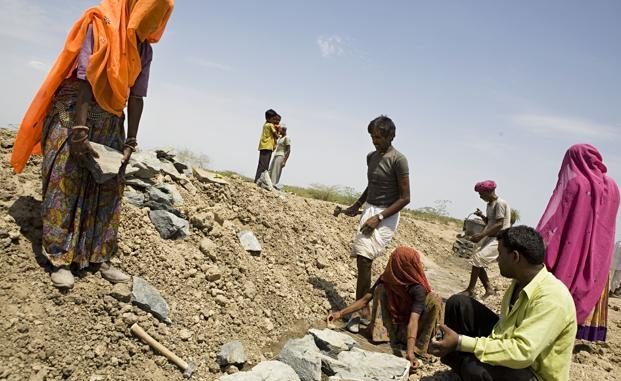
By Tadit Kundu
New Delhi : Five years after India’s official statistics recorded a sharp decline in the share of women in India’s labour force, a new large-scale survey conducted in 2016 shows that the proportion of working women in the country has barely improved.
The proportion of women in the urban labour force is 24%, while that in the rural labour force is a bit higher at 29%, according to the Household Survey on India’s Citizen Environment & Consumer Economy (ICE 360° survey), conducted last year. The survey covered a representative sample of 61,000 households, making it one of the largest household surveys in the country since the National Sample Survey Office (NSSO) conducted the “thick round” in 2011-12. The (adjusted) female labour force participation rate calculated from the ICE 360° survey data differs slightly from the NSSO definition.
Overall, the proportion of women in India’s labour force (rural and urban put together) is 27.4%, according to the survey. Out of every 10 persons in the country’s labour force, only 2 are women. These findings broadly corroborate the findings of the National Family Health Survey (NFHS) conducted in 2015-16, which shows that the proportion of working women who were paid for their work fell 4 percentage points over the past decade to 24.6%.
Unlike its Asian peers, which saw a sharp increase in the proportion of women workers as their growth rates picked up, the Indian economy has seen the share of women in the labour force decline precisely when it has been growing the fastest.
India’s female labour force participation rate at 27% is among the lowest in the world, and far lower than Asian peers such as China (63.9%) or Nepal (79.9%), World Bank data shows. Only in Pakistan (24.6%) and the Arab World (23.3%), the proportion of women in the labour force is lower.
One reason for the lower participation of women in the Indian labour force is the rise in enrolment rates, which has led many young women to pursue education. Another reason could be rising prosperity itself, research suggests. For many women workers in India, the decision to seek work is often driven by necessity rather than economic opportunities. Thus, economic prosperity allowed women to reduce distress-driven employment. This explanation, first articulated by labour economist Jayan Jose Thomas of the Indian Institute of Technology, Delhi, finds support in a recent World Bank research paper by economist Luis A. Andres and his colleagues.
The ICE 360° survey also seems to suggest that it is mostly the poor, rural, and illiterate among Indian women who choose to (or are allowed to) join the labour force, confirming the trends observed in the NSSO data.
Of course, the very rich households are an exception to the trend and report a higher proportion of female earners. Such a ‘U-shaped’ pattern in women’s workforce participation gets starker when one considers their educational qualifications. In both rural and urban areas, women who are either illiterates or graduates are most likely to work or to seek work. Those with middle-level educational qualifications are unlikely to be in the labour force, the data shows.
The survey shows that 71% of illiterate urban women reported catering to “domestic duties” as their main (or “principal”) activity (excluding women who are pursuing education or too old or too young or unfit to work). This ratio is higher for urban matriculate women at 82% and lower for urban graduate women at 68%.
On average, 76% of women were primarily engaged in “domestic duties” in urban India, while 71% reported being engaged in such activities in rural India. Although female labour force participation is higher in rural areas, it is mostly in casual labour. The share of salaried women is much higher in urban areas, the survey shows.
The ICE 360° survey was conducted by the independent not-for-profit organization, People Research on India’s Consumer Economy, headed by two of India’s best-known consumer economy experts, Rama Bijapurkar and Rajesh Shukla.
The findings of the latest survey seem to indicate that apart from the poorest and richest households, most women in India tend to forsake job opportunities in favour of their domestic duties. In a patriarchal society such as ours, a woman attending only to domestic duties is often deemed to be a marker of higher familial status across large swathes of India. As a 2010 research paper by economists Mukesh Eswaran of the University of British Columbia, and Bharat Ramaswami and Wilima Wadhwa of the Indian Statistical Institute, Delhi, showed, the amount of time a woman spent working outside her home tends to be lower as one climbs up the caste and income ladder in rural India.
Although such societal attitudes may be changing, the process has been slow. While India’s youth has become more liberal than before, on questions relating to gender roles, a majority still retains conservative attitudes. Less than half of young men and women under the age of 35 believe that it is all right for women to work after marriage, according to the recently published findings of a national youth survey conducted jointly by the Centre for the Study of Developing Societies (CSDS) and Konrad Adenaeur Stiftung (KAS) in 2016.
If the trends of the past few years are anything to go by, it is unlikely that the forces of patriarchy will yield easily. It is more likely that as income levels rise, the proportion of working women falls in the country instead of rising.
This story is based on the latest results from the ICE 360° survey conducted by the People Research on India’s Consumer Economy (PRICE) in 2016, and shared exclusively with Mint.
Source: Livemint

Leave a Reply